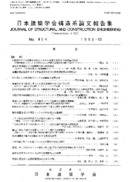379 巻
選択された号の論文の18件中1~18を表示しています
- |<
- <
- 1
- >
- >|
-
原稿種別: 表紙
1987 年 379 巻 p. Cover1-
発行日: 1987/09/30
公開日: 2017/12/25
PDF形式でダウンロード (50K) -
原稿種別: 表紙
1987 年 379 巻 p. Cover2-
発行日: 1987/09/30
公開日: 2017/12/25
PDF形式でダウンロード (50K) -
原稿種別: 目次
1987 年 379 巻 p. Toc1-
発行日: 1987/09/30
公開日: 2017/12/25
PDF形式でダウンロード (48K) -
原稿種別: 付録等
1987 年 379 巻 p. App1-
発行日: 1987/09/30
公開日: 2017/12/25
PDF形式でダウンロード (55K) -
原稿種別: 付録等
1987 年 379 巻 p. App2-
発行日: 1987/09/30
公開日: 2017/12/25
PDF形式でダウンロード (55K) -
原稿種別: 本文
1987 年 379 巻 p. 1-14
発行日: 1987/09/30
公開日: 2017/12/25
PDF形式でダウンロード (1606K) -
原稿種別: 本文
1987 年 379 巻 p. 15-25
発行日: 1987/09/30
公開日: 2017/12/25
PDF形式でダウンロード (883K) -
原稿種別: 本文
1987 年 379 巻 p. 26-33
発行日: 1987/09/30
公開日: 2017/12/25
PDF形式でダウンロード (841K) -
原稿種別: 本文
1987 年 379 巻 p. 34-37
発行日: 1987/09/30
公開日: 2017/12/25
PDF形式でダウンロード (342K) -
原稿種別: 本文
1987 年 379 巻 p. 38-48
発行日: 1987/09/30
公開日: 2017/12/25
PDF形式でダウンロード (1003K) -
原稿種別: 本文
1987 年 379 巻 p. 49-57
発行日: 1987/09/30
公開日: 2017/12/25
PDF形式でダウンロード (1123K) -
原稿種別: 本文
1987 年 379 巻 p. 58-70
発行日: 1987/09/30
公開日: 2017/12/25
PDF形式でダウンロード (1249K) -
原稿種別: 本文
1987 年 379 巻 p. 71-78
発行日: 1987/09/30
公開日: 2017/12/25
PDF形式でダウンロード (753K) -
原稿種別: 本文
1987 年 379 巻 p. 79-90
発行日: 1987/09/30
公開日: 2017/12/25
PDF形式でダウンロード (1200K) -
原稿種別: 本文
1987 年 379 巻 p. 91-92
発行日: 1987/09/30
公開日: 2017/12/25
PDF形式でダウンロード (244K) -
原稿種別: 本文
1987 年 379 巻 p. 92-93
発行日: 1987/09/30
公開日: 2017/12/25
PDF形式でダウンロード (249K) -
原稿種別: 付録等
1987 年 379 巻 p. App3-
発行日: 1987/09/30
公開日: 2017/12/25
PDF形式でダウンロード (68K) -
原稿種別: 表紙
1987 年 379 巻 p. Cover3-
発行日: 1987/09/30
公開日: 2017/12/25
PDF形式でダウンロード (8K)
- |<
- <
- 1
- >
- >|
